I wrote up this review for another website, but figured hey, the secret must be put out.
In short Intel have released a Celeron that is a bit more capable than they probably planned on it being. Here is the review


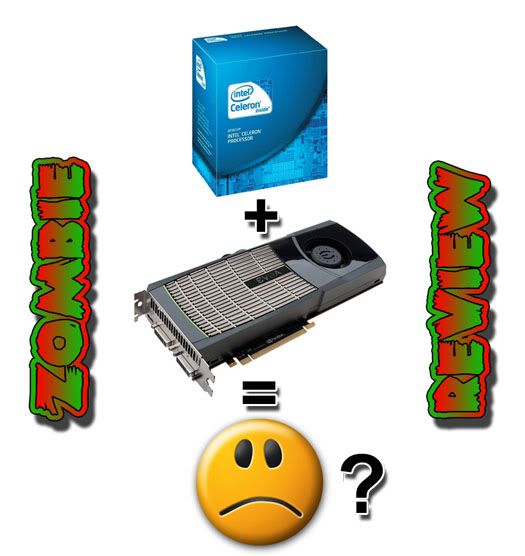
Ugh. Normally when writing reviews I come up with a snazzy interesting title. Today though I can't be bothered. Could be the heat, could be that I'm all out of ideas. Generally this review is about pitting an ex top end CPU that cost over two hundred pounds up against a CPU that costs thirty pounds. You did indeed read that right, thirty pounds. Quite remarkable that you can get something that actually goes into a CPU socket and makes a computer work in this day and age for thirty pounds, but what exactly is it capable of? would it just be a better idea to squish a slice of potato into the socket? well hopefully after today's review it should be clear.
The processor in question here is the bottom of the pile. It is the cheapest, crappiest CPU on the market from Intel. It is, of course, the Celeron G530. I've noticed by looking around this big old internet of ours that some like to refer to it as a Pentium G530. It isn't, of course. I guess the main problem in today's age is that people like to show off when visiting the internet and thus don't want to admit that they're fucking skint and had to buy the lowest common denominator in the processing world.
That's O.K of course, it's always been like that. No one wants to admit that they have to make sacrifices when they make purchases and we all want the world to think highly of us no matter how stupid we look.
For many years the name Celeron has been attached to not having any money when building a P.C. Either that or you just wanted a P.C that performs certain functions that are not in need of any real processing power. That said the Celeron has always been the fat ugly girl of the computing world. No one wants to admit they have one, but they don't mind having a go in private.
Excuse my insipid rambling. I blame it on the weather. I'm short on ideas so for the past five hours I have been drinking lots of coffee trying to get myself into a state of excitement so I can become enthused and pass that enthusiasm onto my readers as I often try to do. Today I can't be fucked, so you're just going to have to take it as it comes.
So, enough of that gay banter, let's get onto what the fuck this is all about. In these tests I have pitted two very similar computer systems against each other to see if having a shit processor hampers what you can actually do with that computer. We all know about
bottle necking as it is a term that has been absolutely fucking rife in the computing world since the graphics processors overtook the central processors. Yes, you read that right. It is now perfectly possible and plausible that you can have so much graphical power that your processor holds it back and puts it in a choke hold similar to something the Hart Foundation would be good at.
And that, my friends, is what I aim to do in this review. Of course no one goes out and buys a thirty pound processor and puts it with very expensive hardware. No one buys a 875 watt 80+ silver power supply with more amps on the rails that a cow has vagina. But what happens if you do do that? what happens if you take a high end gaming machine and plop a shit processor into it? Now we are going to find out.
Our two tests systems today consist of the following. Note - I have tried to keep them fairly balanced on absolutely everything right down to the hard drive. This way no one can accuse me of putting out lop sided benchmarks full of naff information. The only major difference these benchmarks will need is the actual processor itself, with absolutely all other variables eliminated. I would do all of that "And in the red corner" bollocks but again, I find myself seriously lacking in enthusiasm today. So without further ado, here are the systems that will make up the comparisons.
System one ; our reference PC.Intel I7 950 Nehalem at stock speeds of 3ghz with 3.2ghz turbo
Foxconn Flamingblade socket 1366 motherboard
6gb 1333mhz DDR3 running at 1066mhz (non XMP in X58 machines doesn't work very well)
EVGA GTX 480 at stock speed
Corsair Force Series 120gb SSD
250GB Seagate Baracuda
System two ; our "pouring perfume on a pig" PCIntel
Celeron G530 Sandy Bridge at 2.4ghz locked
Asrock H61-MVS micro ATX motherboard (tipping the scales at a whopping £35)
4GB Corsair Vengeance Blue LV 1600mhz DDR3 @ 1066mhz (locked to the CPU's FSB)
EVGA GTX 480 at stock speed
Corsair Force Series 60GB SSD with the same R/W speeds of the 120gb in the big PC
250GB Seagate Baracuda.
So. As we can see the machines are very similarly specced out all barring the actual CPU itself. The memory is running at the same speeds. The SSD drive on which the operating system sits is the same, and they are both running
Windows 7 Home Premium 64 bit with all of the latest drivers and Direct X versions installed.
Test one - Windows "shitty stupid and pointless" Experience Index.Some people actually care about this. Others worry about it and spend money trying to increase it. Fucking madness eh?
Celeron G530 based system
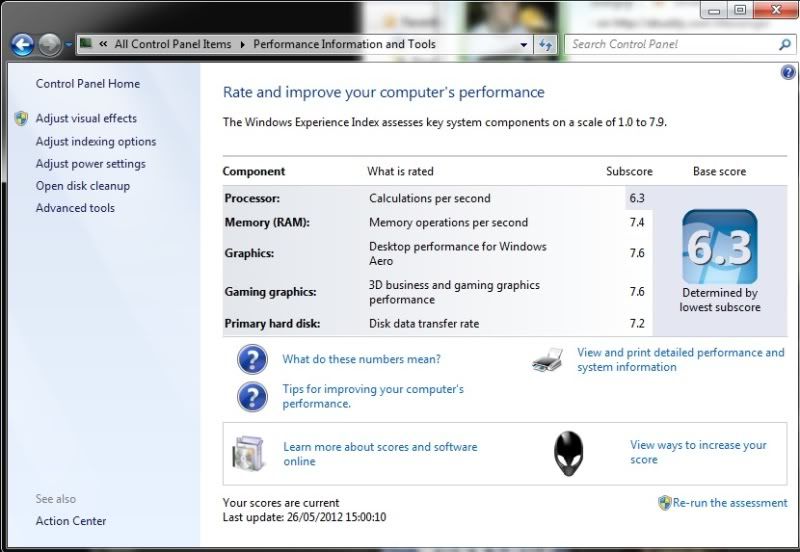
Intel Core I7 950 based system

The only thing worth noting there
at all is that the Celeron scored around two thirds of what the I7 950 scored. This will become a bit more interesting as the tests go through.
Test two - 3Dmark Vantage3Dmark Vantage is getting on a bit now. Given that both of our machines are fully 64 bit
and DX11 capable it could be said that Vantage could now be seen as venerable and rather irrelevant. However, it is a good way to show the difference on two computers so it can still be used as a valid comparison.
First up our little
Celeron 530. By the time I am done writing this review we will all have blonde hair, blue eyes and big dicks and call it a Celeron. Idealism, I fucking love it.
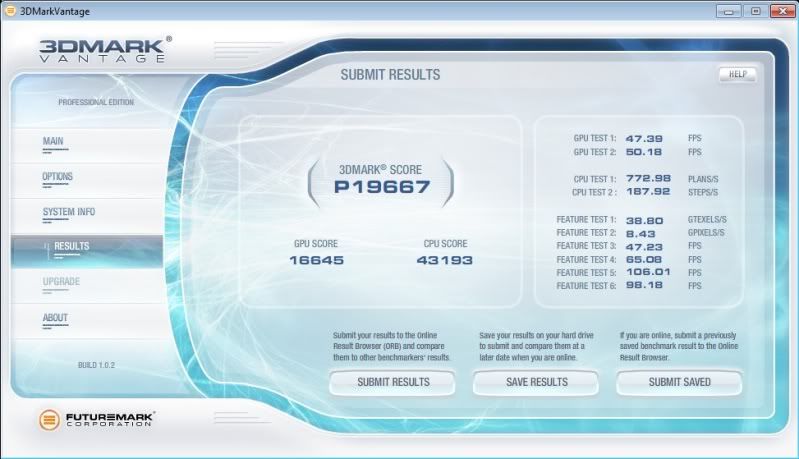
And then it was over to our more macho machine for a run of the same benchmark.

Hmm. How impressive is that? One thing is pretty clear from the Vantage tests, and that is 3Dmark Vantage obviously is not CPU dependent and only really cares about your graphics card. Before you say it yes, I did wonder if the CPU was going to cause issues later on. I now know the answer to that but you don't. As the tests continue however it will become more apparent. The most interesting thing to note on the Vantage runs was that once again our score was around two thirds of the I7 950's results.
O.K. so now we have done playing with Granddad and sitting on his wee smelling knee let's play with something rather more modern, shall we? It's
3Dmark 11 time, and older hardware need not apply as it simply refuses to run.
Test three - 3Dmark 11First up our little Celeron.
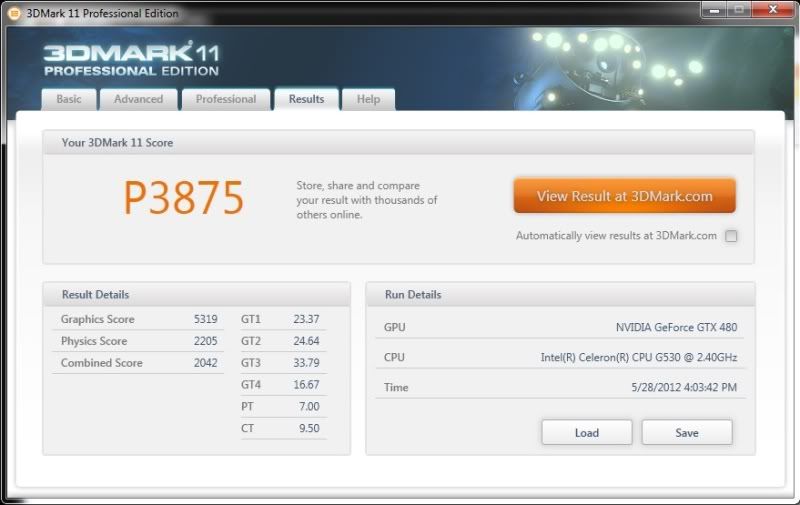
And then onto the I7 machine.

Oh dear oh dear. As the ante increased the poor little Celeron was left busting a nut desperately trying to keep up. Sadly though 3Dmark 11 proved too much for it. If you didn't know 3Dmark 11 is based upon numerous tests. It starts out by making your graphics hardware excrete its internal organs through its mouth, then moves onto making your CPU excrete its internal organs through its mouth, then moves onto both. Where the Celeron faltered however was in the CPU physics test. It was actually painful to watch. The best it could muster was around one frame per second, and it even needed time out every twenty seconds or so to pause and have a think about what was going on. The graphics tests however went very well, but as soon as any pressure was put onto the CPU it merely crumbled

However, all was not lost. Once again the Celeron machine managed to proudly put out an overall score around two thirds of that from the once very expensive computer. And after all, this is
still a thirty pound processor. We simply must not get above ourselves and forget that.
Test four - Unigene Heaven 3.0It's long been said that Heaven is not CPU intensive. It's been assumed that it only really uses your graphics card for the test, leaving the CPU a chance to go on a break. Oddly this turned out to be utter bullshit.
Celeron G530
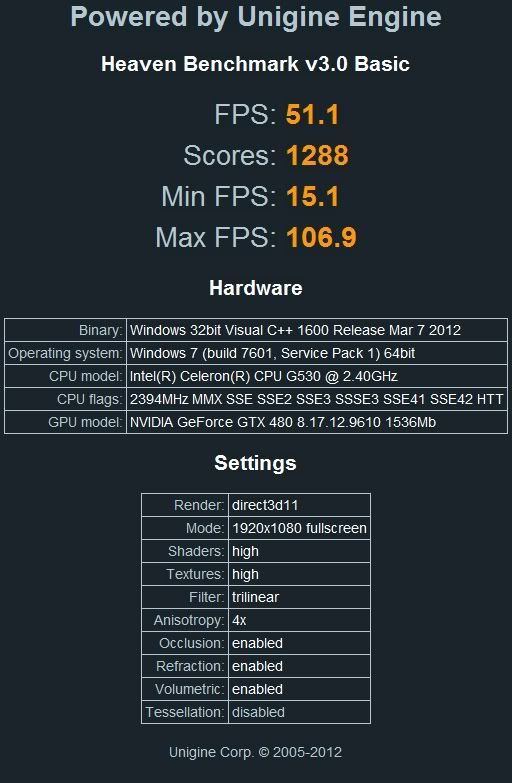
Intel I7 950
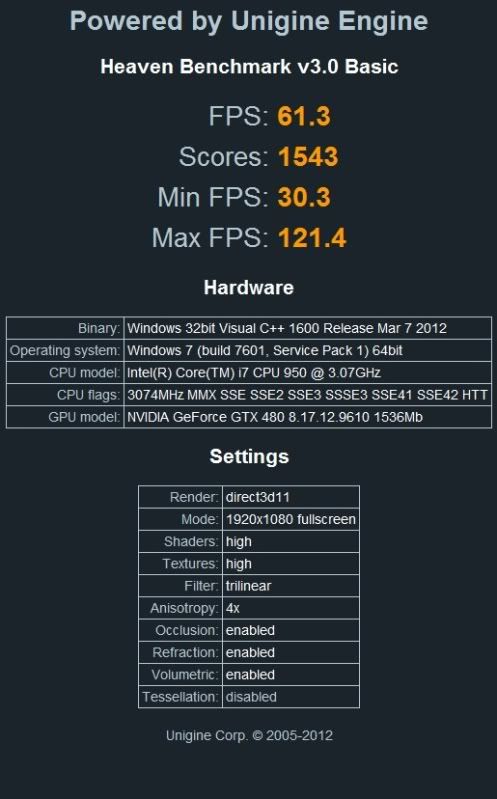
What is very strange about Heaven is that even though the frame rates seem quite high it really was a stuttering mess. I don't know if it is down to something beyond my control, but even when the counter was showing 40 FPS it was still stuttering its as s off.
It was now time for something more interesting. How can our thirty pound CPU perform in high end high settings gaming? let's find out.....
Gaming test one - Mafia IIOur settings for the game were quite simple. Everything on as high as it will go. However, as I was pre warned about turning Apex Physx to high (the GTX 480 doesn't like it. Come to think of it neither does the GTX 580) I decided on medium. As many others have managed to pick out there is hardly any difference between the two, yet medium allows our machine to work at a reasonable pace. For this test I ran the inbuilt benchmark, and anti aliasing was turned on.
Celeron G530

Intel I7 950

O.K. So we now know that even though Physx is included in Mafia II, and even though the CUDA cores should be doing pretty much all of the hard work, our Celeron was still left wanting. That said even the I7 950 machine struggled to keep the game and playable frame levels. I will point out, though, that the benchmark in this game does not depict the actual game itself nor its frame rates. They are always much higher in game due to it not being a test of strength.
Game test two - Metro 2033A game that was designed to cripple your system. A game that is a bit messy, yet in places will actually stop you and make you admit it really is a rather lovely mess.
Celeron G530
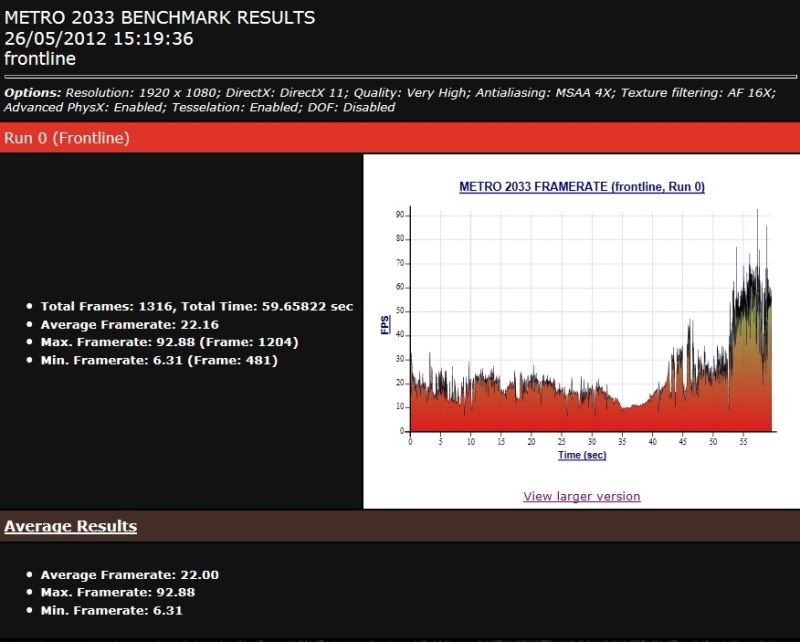
Intel I7 950
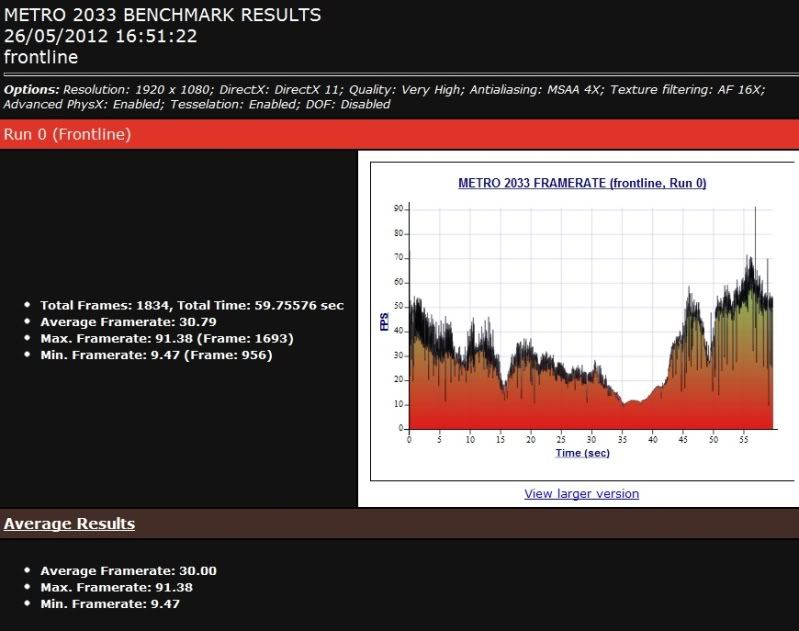
Now what actually surprised me in this test wasn't that the Celeron again lost. No. It was more that the Celeron was far closer to the I7 950 than it really should have been. This makes one thing quite clear ; Metro 2033 isn't really very bothered about having a super CPU inserted into its bottom, and it is quite happy to ruin any system no matter what the CPU.
Game test three - Dirt ShowdownCodey's latest and greatest? actually yes, it seems to be infinitely more fun than Dirt 3 and even a little bit more fun than Dirt 2. Again our settings were DX11 enabled and pushed to ultra.

And the Intel I7 950

And once again we are back at that "two thirds as good" scenario. Dirt Showdown is
far more physically intense on a computer's hardware than any of the games before it. Graphically at a glance it does not look much better than before. However, it is. There is far more going on graphically in the levels than before, where some of the tracks were rather sparse.
The amazing thing about the Dirt Showdown tests is that the Celeron actually provided perfectly playable levels of gaming grunt. Yes yes, we all like to play our games at sixty frames per second. However, going by Thomas Edision's theories on frames per second we will know that 26.7 frames per second is more than enough to provide our eyes with a smooth enough experience. It could be said that demanding sixty frames per second from a thirty quid CPU would be rather unreasonable.
Our last test is
The Elder Scrolls - SkyrimThis time I wasn't able to be lazy and simply take a screenshot, as Skyrim does not have an inbuilt benchmark mode. However, I was able to use FRAPS to record some FPS counts.
Again, the game was set to Ultra settings with 16X anisotropic filtering and 8xMSAA. Yes yes, I know that there is no real point to using more than 4XMSAA, but whatever. I wanted to push the game to the limits to see what the hardware was capable of.Also note that to disable Vsync in Skyrim involves hacking around your config files. I figured that what was important here was the minimum and average frames per second, and the Celeron would not be capable of battering out 60+ FPS any way. Turns out I was right.
Celeron G530
Frames - 3577
Min FPS - 24
Avg FPS - 39.744
Max FPS - 60
Intel I7 950
Frames - 5182
Min FPS - 45
Avg FPS - 57.578
Max FPS - 60*
*noting of course that the limit will be 60 FPS given I have vertical synchronisation enabled on my 60 hz monitor.
What shocked me about the results were that Skyrim, like other Bethsoft game engines doesn't really care for lots of cores. However, even though the Celeron wasn't "Core limited" per se it was definitely holding back our GTX 480 from knocking it out of the park.
The conclusionSo, should you go out and build a high end gaming computer based around this thirty pound wonder chip? No.
Of course, at no time during what was going on did I
really think that the Celeron was going to become commonplace in powerful high end computers. I knew that the low clock speed, lack of cores and lower cache was going to hinder the GTX 480. I knew that the Celeron was not going to be capable of opening up and letting the GTX 480 do everything it can to improve gaming. However, what I wasn't prepared for was for the Celeron to basically put out scores that were
at least two thirds as high as the scores the I7 mustered. Sadly, when all was said and done though the Celeron just wasn't capable of opening up enough to let the GTX 480 stretch its legs fully, as thus as you can understand it is not worth spending around £200 on a graphics card and then pairing it up with the Celeron.
But.
The Celeron is, quite frankly,
fucking amazing.At all times we absolutely must remember that this is a crippled, cut down, held back, locked up processor that costs
thirty pounds. And whilst it may not be worth basing a high end gaming computer around it it stands out to be put with good graphics cards such as the GTX 460, 560 (non TI) and Radeons in that price bracket. I have no reservations
at all that the Celeron would not be completely in its element with a mid ranged graphics card.
It's been many years since a truly cheap budget processor has been capable of anything at all, let alone actually being able to game and be of more use than just a general word processor. This must worry AMD a lot right? well no. The stupid part is that Intel have not even bothered to try and let people know how good this Celeron is. I mean sure, at thirty quid they're not exactly going to be running around shouting out how their £70 Pentiums are a waste of money, but they could at least have taken the time to show that the Celeron on computing power absolutely trounces the low priced AMD chips. For £30 AMD offer us a single cored processor that can barely make its way into Windows. Running something such as 3Dmark 11 would take about a week, and you will end up wishing you hadn't.
For media PCs the Celeron is an
absolute no brainer. I currently see many systems being split up and sold, and an old shitty core 2 duo being paired up with a crusty old board and some DDR2 and then command an asking price right around that of the Celeron. Not only that, but paired up with something like the Asrock H61-MVS and some cheap DDR3 and for argument's sake a Radeon 6850? you would have a very pokey little mid ranged gaming PC that is perfectly capable of playing any game on the market, all be it at reduced settings.
I would imagine that Intel did not intend to supply as much as they have with the Celeron. It think it simply came down to the fact that the Celeron is based on the Sandy Bridge architecture. And no matter what Intel seem to do with that architecture is it successful.
Funny really, but for the first time in many years the name Celeron is actually something you can say with a proud smile on your face.

